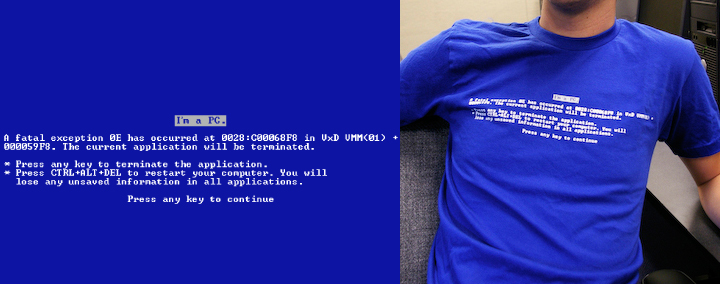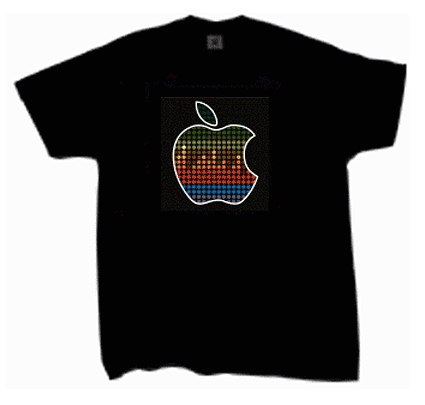TidBITS#991/17-Aug-09
We have a wide selection of Apple-related topics for you this week, starting with Glenn Fleishman’s look at Apple’s latest Security Update (don’t worry, it’s not something most people need to install immediately). Glenn also looks in depth at the significant drop in pricing for the CrashPlan Central hosted backup service. Meanwhile, Doug McLean reports on the return of the matte screen option for the 15-inch MacBook Pro and compiles a list of his top ten favorite Apple t-shirts. Finally, Adam covers Microsoft’s announcement of the forthcoming Outlook for Mac and other changes in Microsoft Office. Notable software releases this week include Default Folder X 4.3, PCalc 3.5, AirPort Client Update for MacBook and MacBook Pro, PDFpen 4.2, Safari 4.0.3, Cocktail 4.4.1, SubEthaEdit 3.5, and Audio Hijack Pro 2.9.2.
Security Update 2009-004 DNS Patch Applies to Few Systems
Security Update 2009-004, Apple’s latest update to the domain name service (DNS) software found in client and server versions of Mac OS X 10.4 and 10.5, is critical – but affects only those people who have manually enabled Mac OS X’s DNS server.
This includes system administrators using the DNS server in Tiger Server or Leopard Server for name resolution where the DNS servers can be reached in any fashion from outside a local network. It also includes a very small number of people who like to monkey at the command line and happened to enable DNS on regular Tiger or Leopard systems.
The flaw that the update fixes could disrupt a network by allowing a remote attacker with no other access to a company’s network to kill a DNS server. It’s likely that Apple servers represent a nearly invisible fraction of all public-facing DNS servers worldwide, and thus few attackers would try to exploit this now-patched problem.
Security Update 2009-004 for Mac OS X and Mac OS X Server 10.4.11 and 10.5.8 has nothing to do with fundamental DNS flaws that Rich Mogull and I wrote about in “Apple Fails to Patch Critical Exploited DNS Flaw” (2008-07-24) and Adam Engst and I updated with “Apple Finally Fixes DNS Flaw and ARDAgent Vulnerability” (2008-08-01).
DNS still suffers from a fundamental design flaw that last year’s patches ignored – the problem is enormously harder to exploit but wasn’t eliminated. DNS’s security infrastructure has to evolve to embed cryptography in such a way that a request to turn a human-readable domain name into something else can’t be spoofed by an attacker.
Matte Screen Option Returns to 15-inch MacBook Pro
Apple has quietly reintroduced the antiglare matte display as a premium option to the 15-inch MacBook Pro. Recently, and without notice, the company updated its online store to offer the antiglare display option for $50. The option had been available only for the 17-inch MacBook Pro. The 13-inch MacBook Pro and 13-inch MacBook remain available only with a glossy display.
In October 2008, Apple moved the unibody MacBook and MacBook Pro lineup to glossy displays, doing away with an option for a matte screen. The 17-inch MacBook Pro, released in January 2009, retained the option for a matte display. (For details, see “On the Way Out: FireWire and Matte Screens?,” 2008-10-18.)
It’s worth noting that Apple also brought FireWire back with the new 13-inch MacBook Pro, leaving the MacBook Air as the only Mac without FireWire; see “Apple Refreshes MacBook Line at WWDC,” 2009-06-08.
The decision generated a thunderstorm of scorn from users who found the glossy display’s glare to be a distraction. Most people agreed that the new displays were brighter, had deeper blacks, and offered more saturated colors, but the inevitable glare that resulted in brightly lit environments caused a divide among users. While many found the glare easy enough to ignore – or at least worth the trade-off for better colors and brightness, others found the reflection to be too distracting.
Underlining the vitriol was the fact that Apple had removed what many felt was an essential option, rather than acknowledge differing opinions on such a central design feature. While it’s easy to see why Apple would want to streamline options with consumer-level systems, to do so for models targeted at working professionals was insulting.
Many MacBook Pro users are design and graphics professionals who spend their days tweaking subtle visual details. If Apple expected these users to continue buying premium systems, the company needed to acknowledge that not everyone fits comfortably into the same box; that’s especially true with visual perception, where opinions on what’s best vary widely. Wasn’t this the company that encouraged us to Think Different?
Given this context, Apple’s reversal deserves some applause, as it’s apparent the cries of snubbed users have been heard. Yet there remains the issue of the 13-inch MacBook Pro. If Apple truly sees the smallest MacBook Pro model as appropriate for professional users (and we think it is), why should it be denied the display options of its larger brethren?
Outlook for Mac Due with 2010 Office Release
Entourage, the email client in Microsoft Office for Mac, will see the end of its 10-year run late in 2010, when the next version of Microsoft Office will replace it with a completely new version of Outlook for the Mac (for our introduction to Entourage, see “Entourage: The Grand Tour,” 2000-10-09).
Entourage is far more than an email client, of course, also including a Usenet newsreader, contact manager, calendar, task manager, and other features. Outlook for Windows offers all those features and more, and works particularly fluidly in large organization environments that use Microsoft Exchange Server for shared messaging and collaboration.
We suspect the change from Entourage to Outlook for the Mac serves three purposes:
- It helps Microsoft emphasize the cross-platform compatibility between Office for the Mac and Office for Windows. The differences between Entourage and Outlook have long been a sore point in mixed platform networks.
- It makes for a clean break from previous limitations in Entourage. Microsoft plans to write Outlook for Mac from the ground up as a Cocoa-based application, giving it an entirely new content database. Entourage was originally written using Carbon (since it predates Mac OS X), which would prevent it from taking full advantage of Snow Leopard’s features. Also, Entourage’s reliance on a single-file database made it a non-starter for some people, who would go around muttering about putting too many eggs in one basket that was troublesome from a backup perspective. And, to be fair, catastrophic corruption of the Entourage database, while extremely uncommon, is not unknown.
- It may, by virtue of being a clean code base, make it easier to add new features, such as Microsoft’s Information Rights Management, which helps restrict sensitive information for those who are authorized to see it.
All this said, Microsoft said that Outlook for Mac won’t just be a clone of Outlook for Windows. Aside from being written from the ground up using Cocoa, it will offer integration with Time Machine and Spotlight.
Entourage, Then and Now — This won’t be the first version of Outlook for the Mac. Office 98 for Mac came with Outlook Express 4.0 (related to Outlook mostly in name), and the Exchange Server group within Microsoft developed Outlook 98 and Outlook 2001 for Mac to provide Exchange Server compatibility on the Mac.
Entourage replaced Outlook Express in Office 2001 for Mac, but it initially had no support for Exchange. Starting with Entourage X 10.1.4, Microsoft dropped Outlook for Mac and started adding Exchange support to Entourage, continuing that through Entourage 2004, Entourage 2008, and the just-released Entourage 2008, Web Services Edition.
Entourage 2008, Web Services Edition has been in beta since January 2009, and offers the highest level of support for Exchange Server so far, including:
- Enhanced Autodiscover service for setting up accounts automatically and keeping them up to date
- Synchronization of Entourage 2008 Notes, Tasks, and Categories with Exchange Server
- Use of attachments in Entourage for Exchange calendar events
- Name resolution when composing mail and invites while out of the office without requiring a VPN connection
- Improved logging for troubleshooting purposes
Entourage 2008, Web Services Edition is a free download for anyone using Microsoft Office 2008 for Mac SP2, with all updates applied. On the Exchange side, it can connect only to Microsoft Exchange Server 2007 Service Pack 1 RU4 or later. It runs on Intel-based Macs as well as PowerPC-based Macs (G4s at 500 MHz or faster, and G5s), and is a 64 MB download.
Office Editions Simplified — Microsoft also announced that, as of 15-Sep-09, it is simplifying the number of editions of Office for the Mac available for sale. Currently, there are three versions of Office, and after the change, there will be only two:
- Office 2008 for Mac Home & Student: This $149.95 version exists now and will remain. It includes just Word, Excel, PowerPoint, and Entourage.
- Office 2008 for Mac Business Edition: The $399.95 Business Edition replaces both the $399.95 Standard Edition and the $499.95 Special Media Edition. Along with Word, Excel, and PowerPoint, it will include Entourage 2008, Web Services Edition and Microsoft Document Connection for Mac, plus additional professional templates and clip art, and more than 8 hours of Lynda.com training videos. It will not include Microsoft Expression Media 2, which was part of the Special Media Edition; I’m checking on the overall status of Expression Media.
CrashPlan Central Slashes Hosted Backup Pricing
The price of Internet backups just dropped suddenly with CrashPlan’s change to fixed rates for family and individual backups to its CrashPlan Central service. CrashPlan, like several other firms, previously charged a recurring fee based on the amount of storage you’d consumed. That has now changed.
The new CrashPlan Central plans for personal use for two or more computers costs $100 per year, which works out to $8.33 per month. CrashPlan offers two- and three-year contracts for $150 and $180 ($6.25 per month and $5 per month, respectively). For a single computer, CrashPlan’s yearly $54 fee ($4.50 per month) is comparable to several competitors, including Mozy.
Hosted backup software lets you transfer data from your computer to a data center where your archives are stored in encrypted form. Most backup services, including CrashPlan, store multiple or unlimited older copies of changed files.
Bandwidth use after initial backups is kept as low as possible by sending only “differentials” – the pieces of files that have changed – instead of the entire file. This is also how older versions are retained (and reassembled on restoration) without consuming excessive space.
Backblaze, Carbonite, and Mozy, which all offer unlimited storage as well, each charge a per-computer price. For each computer, Backblaze collects $5 per month or discounts the fee to $50 per year; Carbonite charges $54.95 per year (no monthly option); and Mozy is $4.95 per month, throwing in one month free with a year’s payment ($54.45 total).
For three home computers – as I have – paying a year at a time with CrashPlan Central would save me $50 to $65 per year over the equivalent service from the other three unlimited storage firms. For one or two computers, the cost is comparable.
Other firms like iDrive, Jungle Disk, and SpiderOak charge based on total storage consumed by all computers backed up through a single account. Prices for 50 to 100 GB of storage and two computers work out to be about the same; higher levels of data start to rack up costs much more quickly, however.
Unlimited storage works as a practical business matter because bandwidth has become exceptionally cheap, inexpensive hard drives store vast amounts (and are getting vaster and cheaper all the time), and most people won’t consume hundreds of gigabytes of storage.
The factor working against those elements is that running a data center that requires absolute perfection costs quite a lot. However, many costs are relatively fixed for the data center as a whole, while others increase as a small fraction for each additional user or chunk of storage.
CrashPlan’s plan, therefore, relies on receiving significant recurring revenue that lets them cover operational costs; more users make it easier for those costs to be divided over a larger user base, even as users potentially back up much more data. Some of CrashPlan’s competitors outsource data storage – such as Jungle Disk, which uses Amazon S3 – which means their primary costs to pass along are per-gigabyte transfer and storage fees, which decrease only gradually with higher volume.
Hosted backups rely on our confidence that companies will continue to remain in existence to the point at which we may need to restore a file. We at TidBITS recommend that you have at least two backups, one of which could be an Internet-hosted backup.
Ideally, you’d have at least one local backup of your entire hard disk for fast recovery and file restoration, and a remote backup of your essential files; it’s not necessary to back up applications or the operating system over a relatively slow Internet connection. Some of us use Time Machine or CrashPlan for one backup that archives multiple versions of files, SuperDuper or Carbon Copy Cloner for a bootable duplicate, and CrashPlan Central or another Internet backup service for offsite backups.
This may sound excessive, but most of us have had to resort to multiple backups at various times to deal with data corruption and hardware failure. Without this breadth of backup, we would have lost both critical current and important archival data and in-house software.
Adam Engst and Rich Mogull both use CrashPlan’s peer-to-peer option for Internet backups, having installed hard disks at local friends’ houses to host their backups. When used in this mode, CrashPlan’s offsite backups are entirely free, and they trust that a local disaster will wipe out only one set of data, leaving the remote backup unharmed.
Our backup guru Joe Kissell prefers hosted storage like CrashPlan Central because of the bandwidth and other requirements needed to exchange data with friends. Since I live in an earthquake, flood, volcano, and tsunami zone – Seattle – I assume that the worst case could destroy data storage devices not just at my home and office, but also at multiple other local locations. For more about backup strategies and how CrashPlan fits into them see Joe’s “Take Control of Mac OS X Backups” and its more-focused sibling, “Take Control of Easy Backups in Leopard.”
What sets CrashPlan apart from other backup services is that its software can accomplish all three functions. The same software that backs up to CrashPlan Central can also archive files to a local drive or folder, to CrashPlan Central, and to a computer operated by a friend also running CrashPlan. See “CrashPlan Adds Direct-to-Disk Backups” (2008-12-15), for more background on CrashPlan’s features.
CrashPlan’s one major limitation is an inability to choose different backup sets for each destination. You must archive the same files to local, remote, and peer storage.
The basic version of CrashPlan is free and enables all the forms of backup described. However, for constant backups, a higher level of encryption, and data compression for local and peer-to-peer backups, you need the $59.99 CrashPlan+. Computers backing up to each other can use a mix of CrashPlan and CrashPlan+ software, however, making CrashPlan also especially useful for backing up data from non-technical friends and relatives.
We expect CrashPlan’s pricing may provoke a price war among competing services, as the main differentiator between reliable hosted backup systems is price and a preference for one software package or another.
Top Ten Apple T-Shirts
In his 1990 book, “The Macintosh Way,” Guy Kawasaki draws a flowchart depicting Apple’s process for creating great products. The first step in the order of operations? “Order t-shirt.”
And so, as long as Apple has been around, there has been Apple apparel to clothe its fans. To see what I mean, look no further than Gordon Thygeson’s “Apple T-Shirts: A Yearbook of History at Apple Computer” ($40). The book is chock full of photos of over 1,000 memorable and rare Apple t-shirts from over the years. But the days of great Apple tees are not gone, and there are still great Apple shirts out there today! Here’s a top ten list of my favorite Apple t-shirts you can still add to your wardrobe.
1984 Mac Ad Homage — If you’re of a certain age, you might remember watching the iconic 1984 Super Bowl ad for the first Macintosh in real time. For the rest of us, there’s always YouTube. This shirt, from FastMac, is a subtle homage to that advertisement. With its boldly colored Anya Major silhouette, the design is a nod to the Mac’s emergence to those in the know, and an intriguingly ambiguous image to those who aren’t. ($9.99)
The Spinner — Imagine, every time you put on this shirt displaying the famous Apple spinning gear, it’s like you’re powering up! The simple abstract design from Bird Doctor will be instantly recognized by Mac users, but should you want to hide your geek credentials, this symbol will go undetected by those out of the (Infinite) loop. ($22)
da Vinci iPhone, Exploded — Leonardo da Vinci painted the Mona Lisa, designed an ornithopter flying machine, and, according to this shirt, created the iPhone. (Well, actually, the artist is Kevin Tong, but let’s pretend.) You can also find an exploded Mac shirt as well, designed by Gary Booth, at Dion Briggs’s site. ($20)
I’m a PC, Dying a Slow Blue Death — Take the Mac versus PC debate into your own hands, in a subversive sorta way with this shirt from Indie Tech. ($7.50)
Keyboard Skull — This shirt, designed by Rubyred and available at RedBubble, features a skull assembled from Apple keyboard keys. Yet, it’s only after close inspection that the Command key indicates the keyboard’s allegiance. How should one interpret the design’s meaning? It’s your call, but at the very least, it’s a good conversation starter. ($26.13)
Apple Retro Rainbow — What is there to say? This classic throwback design from Geek/Science can even be printed on a faded yellow shirt to nail that early 1980s look. ($11.99)
The Apple Timeline — A brief history of Apple from Insanely Great Tees: educate those around you, or simply remind yourself of where the time has gone! ($19)
Crazy Light-Up Apple Logo Shirt — Winning the award for wackiest concept, this shirt’s Apple logo responds to audio input by lighting up. Sure, you have to wear a battery pack, but the guaranteed attention it garners for you will be worth it! Unfortunately, likely for legal reasons, the shirt is no longer available at its original online store. Luckily, you can still nab one on eBay! (Buy It Now price: $31.99)
The Bomb — Experiencing an unrecoverable system error of a day? Put on your Bomb shirt from Insanely Great Tees and keep your chin up! Mac OS X’s spinning pizza of death has nothing on the original bomb symbol designed by Susan Kare. ($19)
T-Shirt App — It seems like there’s an app for everything, including getting dressed. Beware, though, since you might get a few unwanted icon taps on this shirt from Zazzle. ($33.75)
Have I missed your favorite t-shirt? While all lists must come to a close, there are certainly many more Apple t-shirts out there, hiding in dresser drawers around the world. If you’ve come across any cool Apple-related shirts that weren’t touched on here, I’d love to hear about them. Happy shirt hunting!
TidBITS Watchlist: Notable Software Updates for 17-Aug-09
Default Folder X 4.3 from St. Clair Software primarily adds full support for the forthcoming Mac OS X 10.6 Snow Leopard to the Open/Save dialog enhancement utility. (Version 4.3 is necessary for Snow Leopard; previous versions crash under 10.6.) It also reduces CPU usage when displaying previews and fixes several compatibility problems. Plus, a new expert setting enables users to resize Open and Save dialogs to at least a user-specified minimum size. ($34.95 new, free update, 10.5 MB)
PCalc 3.5 from TLA Systems brings the popular scientific calculator into feature parity with the company’s iPhone version. In particular it adds new functions, can show additional functions with a “2nd” key, supports multiple memories, offers optional HP48-style RPN behavior, provides key click sounds, and allows use of the quote as a thousands separator. ($19 new, free update, 3.4 MB)
AirPort Client Update for MacBook and MacBook Pro from Apple addresses an issue with wireless network performance when the MacBook or MacBook Pro is running on battery power. The update pertains only to users running Mac OS X 10.5.8 on one of the following systems: the late 2007, early 2008, or late 2008 13-inch MacBook; the early 2008 15-inch MacBook Pro; and the early 2008 or late 2008 17-inch MacBook Pro. (Free, 1.68 MB)
PDFpen 4.2 and PDFpenPro 4.2 from SmileOnMyMac are the latest versions of the company’s PDF editing utilities. The updates add support for 128-bit AES encrypted documents, support for the AppleScript enhanced print event, and other minor unspecified fixes and improvements. ($49.95/$99.95, free updates, 12 MB/12.2 MB)
Safari 4.0.3 from Apple is a security and stability update to the Web browser. The latest version improves stability for Top Sites, third-party plug-ins, and Web pages using the HTML 5 video tag, and helps prevent arbitrary crashing and malicious code execution. The update also fixes an issue that prevented users from logging into iWork.com, and another that caused pages to be displayed in grayscale instead of color. More details on the update’s security content are posted on Apple’s Web site. The update is available via Software Update or the Apple Support Downloads page. (Free, 40
MB/26 MB Leopard/Tiger)
Cocktail 4.4.1 from Maintain is a minor maintenance update to the general purpose maintenance utility. The update fixes compatibility issues with Firefox 3.5 and Flock 2.5, clears the latest RSPlug Trojan Horse variants, adds updated Automator actions, provides compatibility with Mac OS X 10.5.8, and addresses other minor unspecified bugs. ($14.95, free update, 1.9 MB).
SubEthaEdit 3.5 from TheCodingMonkeys is a major update to the collaborative text editor. The latest version adds a code folding feature that enables users to collapse nested bits of source code, a document state persistence capability that saves document states such as window positions, and new clickable URLs that make it easier to open links while editing. Also the speed of AppleScript-based text changes has been enhanced, triggers for a bug in the mDNSResponder that caused high CPU loads when using AirPort base stations have been reduced, and several crashing bugs have been fixed, including one that would occur when opening files larger than 300 MB. A full list of changes is
available via TheCodingMonkeys Web site. (29 euros new, free update, 4.1 MB)
Audio Hijack Pro 2.9.2 from Rogue Amoeba is a maintenance update to the all-around audio recording software. Changes include the use of Instant Hijack 2.1.2, the capability to hijack the same application in multiple sessions simultaneously, and improved saving capabilities in the Recording Inspector. Also, several problems have been fixed, including a bug that caused AAC recordings not to start, an issue with the Add to iTunes script failing, and unresponsive Quick Record hot keys. Finally, for users running Mac OS X 10.4, the update will install the latest compatible version of Soundflower 1.3.1. ($32 new, free update, 7.4 MB)
ExtraBITS for 17-Aug-09
TomTom Releases iPhone Turn-by-Turn Navigation App — TomTom’s turn-by-turn navigation app costs $100 and comes with maps of the United States and Canada. It requires an iPhone 3G or 3GS. There’s no monthly subscription fee, and add-on map packs for other countries are available. A promised car-attachment kit with a better GPS chip is still not yet out or priced. (Posted 2009-08-16)
Alltop Procrastinator’s Clock — Silly, but potentially useful. This Guy Kawasaki-inspired clock application intentionally runs somewhere between 0 and 15 minutes fast, so you can’t try to cut things too close. Oops, gotta go! (Posted 2009-08-16)
Sony Adopts EPUB Format for Electronic Books — Sony said that by year’s end it would switch to the EPUB set of standard formats for electronic books for its online library and Reader devices. EPUB-packaged books can still be wrapped in DRM, but are far more portable among devices and software than proprietary formats. Amazon’s Kindle uses a proprietary book format for its titles, and does not read EPUB packages. (Posted 2009-08-13)
The Scoop on Google’s Caffeine — Google Caffeine is Google’s new search engine architecture. It’s designed to improve search speeds and results for users, but may also have some unexpected results for developers. PC World runs down answers to basic questions concerning the forthcoming changeover. (Posted 2009-08-12)
Fix for MacBook Pro Hard Drive Clicking in the Works — Some MacBook Pro owners with 500 GB 7200 RPM hard drives have been complaining of clicking sounds, followed by a short period of stalled performance. The machines become responsive again after roughly 10 seconds, and do not require rebooting. Apple spokesperson Bill Evans has informed CNET that Apple is aware of the issue and working on a fix, though no definite timetable has been set for its release. (Posted 2009-08-12)
Run-of-the-Mill Mac Trojan in the Wild — Nothing new here: Ars Technica reports on a new trojan horse, disguised as a QuickTime player update, that hijacks DNS requests, sending the victim to the attacker’s Web site of choice. Common sense helps you avoid 99 percent of trojans and this case is no different – if an untrusted Web site instructs you to download and install some piece of software, don’t do it. (Posted 2009-08-12)
So You Found My iPhone — This modestly amusing video from Slate about an iPhone developer who lost his iPhone picks up a bit at the end. (Posted 2009-08-12)
Hot Topics in TidBITS Talk for 17-Aug-09
What Notes Do You Keep on your iPhone/iPod Touch — Readers share the types of information stored on mobile devices, ranging from lists of books to read to copies of the U.S. Constitution. (4 messages)
Apple Upgrade Pricing — With Snow Leopard around the corner, discussion turns to Apple’s lack of upgrade pricing for most applications, especially iLife, and to the license agreements included in the software. (32 messages)
Leopard for G4 DP 450mhz? How does Leopard perform on an older system? (7 messages)
Escaping from AT&T — Apparently, you can get out of your AT&T contract without penalties if you move out of the United States and can prove it. (6 messages)
Suggestions for iPhone SMS & Call Log monitoring? What options are available to keep track of an iPhone’s text messages and phone calls on the Mac? (4 messages)
Mail server woes – LetterRip help sought — A reader using the old LetterRip mailing list software needs help. (2 messages)
Wi-Fi connection problem — Is old AirPort hardware to blame for problems connecting to a wireless network? (2 messages)
Worth It? See (feel) a Difference? Readers respond to a question of whether paying $300 to get the fastest MacBook Pro processor is worth the money, or if it’s better to improve performance in other ways, such as a faster hard disk. (7 messages)










